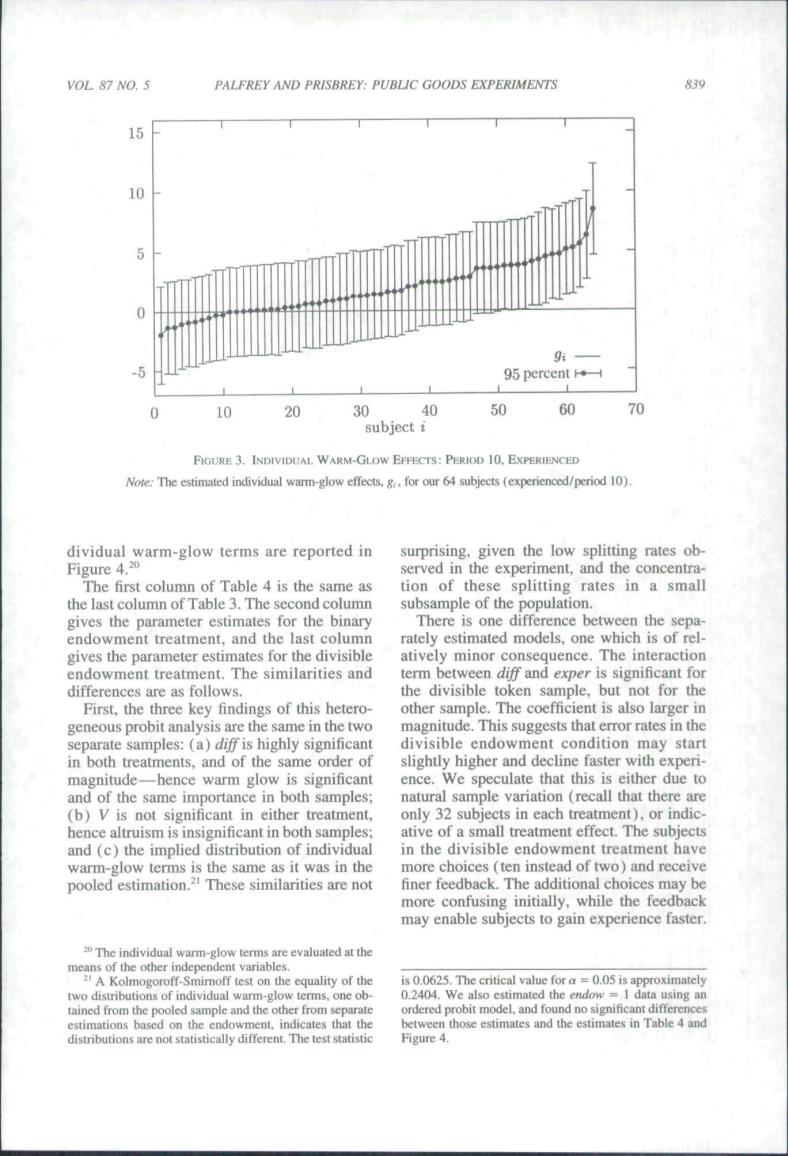正在加载图片...

VOL 87 NO.5 PALFREY AND PRISBREY:PUBLIC GOODS EXPERIMENTS 839 15 91 95 percent 10 20 30 50 60 70 FIGURE 3.INDIVIDUAL WARM-GLOW EFFECTS:PE Note:The estimated individual warm-glow effects.subjects (experienced/period 10) dividual warm-glow terms are reported in surprising.given the low splitting rates ob Figuret colum of Table 4 is the th the last column of Tahle 3 The sec gives the parameter estimates for the binary gives the term bet diff and ex er is differences are as follows the divisible token sample,but not for the First,the three key findings of this hetero- me in t slightly higher and decline faster -hence warm glow is significant ence.We speculate that this is either due to both samples sample variation (recall that there are n and (c)the implie in the divisible endowment treatment have warm-glow terms is the same as it was in the more choices (ten inst ad of two)and receive pooled estimation. These similarities are not finer feedback may b expe ience faster 0625 ora=0.05 404.wc odel.and found no d on VOL 87 NO. 5 PALEREY AND PRISBREY: PUBUC GOODS EXPERIMENTS 839 15 - 10 - 5 - .^yYTf"' " rrT " - A^ - 5 --LL-^ 1 5i 95 percent i-»—i 10 20 30 40 subject i 50 60 70 FIGURE 3, INDIVIDUAL WARM-GLOW EFFECT.S: PERKJD 10. EXPERIENCED Note: The estimated individual warm-glow eflects, g,, for our 64 subjects (experienced/period 10). dividual warm-glow terms are reported in Figure 4."" The first column of Table 4 is the same as the last column ofTable 3, The second column gives the parameter estimates for the binary endowment treatment, and the last column gives the parameter estimates for the divisible endowment treatment. The similarities and differences are as follows. First, the three key findings of this heterogeneous probit analysis are the same in the two separate samples: (a) diffi^ highly significant in both treatments, and of the same order of magnitude—hence warm glow is significant and of the same importance in both samples; (b) V is not significant in either treatment, hence altruism is insignificant in both samples; and (c) the implied distribution of individual warm-glow terms is the same as it was in the pooled estimation,^' These similarities are not ^ The individual warm-glow terms are evaluated at the means of the other independent variables. ^' A Kolmogoroff-Smimoff test on the equality of the two di.stributions of individual warm-glow terms, one obtained from the pooled sample and the other from separate estimations based on the endowment, indicates that the distributions are not statistically different. The test statistic surprising, given the low splitting rates observed in the experiment, and the concentration of these splitting rates in a small subsample of the population. There is one difference between the separately estimated models, one which is of relatively minor consequence. The interaction term between diff and exper is significant for the divisible token sample, but not for the other sample. The coefficient is also larger in magnitude. This suggests that error rates in the divisible endowment condition may start slightly higher and decline faster with experience. We speculate that this is either due to natural sample variation (recall that there are only 32 subjects in each treatment), or indicative of a small treatment effect. The subjects in the divisible endowment treatment have more choices (ten instead of two) and receive finer feedback. The additional choices may be more confusing initially, while the feedback may enable subjects to gain experience faster. is 0.0625, The critical value for a = 0.05 is approximately 0,2404. We also estimated the endow = 1 data using an ordered probil model, and found no significant differences between those estimates and the estimates in Tabie 4 and Figure 4